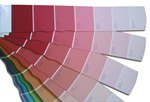
By Michele Green and Barbara Sperling
The color of a room is the foundation of any design. Color can be energizing or calming, welcoming or dramatic. It can camouflage flaws or it can set a mood. Continue Reading this to know how a coat of paint is one of the easiest and quickest ways to transform your home. It is also a critical part of the design process, since the paint color sets the tone of a room. To ensure that your commercial building painting project goes as planned, you may consider hiring commercial painting contractors. And if you need residential painting services, then make sure that you contact residential painting contractors.

House Rule:
According to sites like https://www.europaintinginc.com/commercial-painting, Do not rely on how the color appears on the paint chip. The color will always read differently when it’s in your own home, so test two or three shades of the color you want on your walls and live with the samples for a few days. If possible, paint the samples in two places – next to the window and in a darker corner. This way you can see the colors in a variety of light conditions at different times during the day and at night before making your selection. Just remember that fabulous paint color from your friend’s house may not look the same in yours.
House Rule:
Choose an overall look for your entire house. You can vary the colors within each room, but the colors should flow well throughout the house and not be a patchwork of opposites. For example, stay within a palette of jewel tones or pastels but don’t mix between the two. Even when considering neutrals, try to stay within warm or cool tones. Gray is really a “hot” neutral color this year because it grounds most any room, accents dark wood furniture, and makes accent colors pop. Additionally, use a consistent choice of trim color throughout the house to maintain a cohesive look despite different room colors.

House Rule:
A common misconception is to avoid painting small rooms a dark color because they’ll look too small. No amount of white paint will make a room appear larger than it is. Instead, embrace the smaller spaces, such as a powder room, as an ideal place to experiment with color. Also, don’t forget about the ceiling. Try a muted percentage of the wall color mixed with white. Just bear in mind that the darker the color of the ceiling, the lower it will feel. If you’re interested, you can view here to discover how hiring skilled experts can transform your spaces with expertise and precision.
House Rule:
Consider which paint finish which you can decide and view it here, that might be best for your project. Matte or flat finishes hide wall imperfections but are difficult to wipe down and clean. Glossier finishes will reflect more light but also show all of the wall’s imperfections. If choosing a high gloss finish on the walls, you must ensure that the wall is prepped to perfection and is as smooth as possible. We suggest using flat finish on the ceilings, eggshell on the walls, and semi-gloss for the trim.

House Rule:
Children often prefer bold colors that are too bright for adults. Compromise by choosing softer tones in the same color family of your child’s preference and save the brighter colors for accent pieces in the room that can be easily switched out when you tire of them. This will give more longevity to the room and your child can grow with it. Keep your child safe by choosing intumescent painting instead of any other paint material.

House Rule:
Instead of wallpaper, use paint to create a pattern such as stripes. Using paint to create patterns on the walls can have an equally dramatic impact on the space as any wallcovering. The advantage of using paint is that it can be customized to any shade so there is often more flexibility than using a paper.
The authors are co-owners of The Open House on Purdy Avenue. They welcome your design questions.















